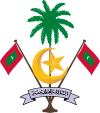Black Friday (2004)
This article needs additional citations for verification. (January 2011) |
Black Friday (
Pursuant to the powers vested in him by Section 144 of the
Demonstration

When police summoned Mr. Mohamed Yusuf, a few reform activists decided to gather near Republican Square to inquire about Yoosuf's detention. What started as a vigil at Republican Square in Malé at dusk on August 12, 2004, turned into a mass gathering of people demanding democratic reform.
As the crowd grew larger and the demands to free Mr. Yoosuf became louder, he was released that afternoon. However, the protesters demanded four other reformists detained in Dhoonidhoo detention centre be transferred to Malé. They also called for the release of Naushad Waheed, Ahmed Didi, Mohamed Zaki and Fathimath Nisreen; all of whom were, according to the Opposition movement, detained without a fair trial.[2] By early morning August 13, 2004, a large crowd had gathered near Republican Square, the NSS building and Shaheed Hussain Adam Building. Initially the NSS and government minister Ilyas Ibrahim unsuccessfully tried to win the trust of the crowd by addressing the crowd over a megaphone. When they failed, they asked the pro-reformist MP Ibrahim Ismail (Ibra) to address the crowd in front of the NSS building.[2] He convinced the crowd to move into nearby Republican Square. Senior MDP activist Muad Mohamed Zaki who was in the front row of the protest blocking the NSS building tried to discourage protestors from moving their position.[2]
After moving the crowd into Republican Square, Ibrahim Ismail addressed the crowd and assured them he would take their demands to the NSS authorities for their consideration. The crowd then gave its demands to Ibrahim Ismail, which were:[2]
- Release of the detained reformists
- Release of Sandhaanu prisoners (Writers of an Internet magazine)
- Release of Naushad Waheed (Artist and reformist)
- Resignation of the President Maumoon Abdul Gayoom
- Resignation of Yameen Abdul Gayoom(Minister of Trade and brother of Gayoom)
- Resignation of Abdullah Hameed(Minister of Atolls and brother of Gayoom)
In the early morning, the reformists were released. They came directly from the Dhoonidhoo detention centre to Republican Square. There they addressed the crowd, criticized Maumoon Abdul Gayoom and called for his resignation. They also demanded the demonstration be reported live on state run television and radio.[2] However, no news of the protest was transmitted yet. The crowd continued to grow and "took (on) a life of its own", as later described by Ibrahim Ismail in his interview on the BBC.[citation needed]
At around 0700 hrs
Crackdown
As the calling for
At around 0830hrs, a person named Hussain Yoosuf stabbed two police officers. He is one of the many people who testified before the
After Friday prayers, at around 1430hrs NSS issued final warning to the crowd. However they refuse to leave the Republican square.[2] Using the previously described commotion as an excuse, the riot police pounced on the protesters, beat them brutally with truncheons and arrested a number of protesters. Women were also beaten with truncheons and they sustained severe injuries. Ambulances were rushed to the hospital with casualties. Tear gas was used on the crowd at around 1500hrs. Senior MDP member Muad Mohamed Zaki was violently beaten by seven NSS officers with wooden planks in broad daylight as he was dragged to the NSS Headquarters. This alerted the British Parliament and European Union officials that Muad was communicating closely with while he staying in the UK representing Maldivian Democratic Party and working to free Sandhaanu political prisoners in Maldives. Thousands of protestors were blindfolded, handcuffed and beaten on that day as law and order seemed to have temporarily disappeared.
State of Emergency
President
After nearly two months, the State of Emergency was lifted due to International pressure.
Internet and SMS service taken offline
Local media reporting
Both
Special programs were aired on Radio and Television to cover-up the real reason behind the protest. It was portrayed by the local media to be a violent mob that attacked police building, government properties and attack police officers. One sided, biased reporting was aired for weeks on the local media.[2]
One year anniversary demonstration
On August 12, 2005, to mark the first
Despite heavy police presence,
At around 4:23pm, riot police moved into Republican Square. Soon they surrounded Mohamed Nasheed along with other members of the party, present with him. Nasheed and his colleagues still refused to stand up. Members of riot police then forcefully removed them and had them taken into the nearby NSS headquarters. This led to civil unrest in Malé and some other atolls, that lasted for three nights. The unrest was controlled and several people were arrested.
References
- ^ "Maldives: Peaceful demonstrators beaten and detained". Amnesty International. 13 August 2004. Archived from the original on 7 March 2005.
- ^ a b c d e f g h i j k l m n o p "Eye-witness account of events on 12-13 August 2004 at the Republican Square, Male' Maldives". Maldives Culture. 14 August 2004. Archived from the original on 20 February 2011.
External links
- Photo album
- More photos of Black Friday
- Black Friday deals 2014 Walmart
- Amnesty International press release
- BBC reporting
- Eyewitness account
- Censorship in the Maldives
- Significant events in chronological order
- Photos
- Blog posts (Content may not be neutral) [1] [2]

